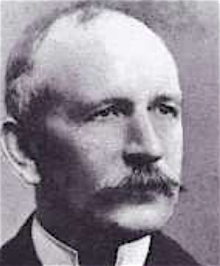
Frank Walter Mee [also known as Frank W. Mee] was born in Lawshall, Suffolk, England on 6 May 1854. He was articled to George Tunstal Redmayne (1840-1912) in Manchester in 1866 and remained with him for thirteen years during which time he attended Manchester School of Art. He subsequently worked as an assistant to Peter Peirce in Stockport; William Morton (1833-1895) and Henry Bridgford of Horton & Bridgford for five months; and Charles John Maycock for six months.
Mee commenced practice as an architect in Manchester in 1882 [or 1883 - sources differ] and from 1885 to 1887 [or 1887-88 - sources differ] was in partnership with Alfred Steinthal (1859-1928) as Mee & Steinthal; from c.1900 with John Jennison (1867-1922) as Mee & Jennison; and with Tom Williamson Hooley as Mee & Hooley in 1902-03.
His entry in Who's Who in Architecture 1914 shows that he not only designed buildings in the Manchester area but in Orange River Colony (South Africa), India and Jamaica.
Mee was Vice President of the Manchester Society of Architects in 1882 and elected a Fellow of the Royal Institute of British Architects (FRIBA) in 1896. He was the author of Sketches of Old Buildings in the Neighbourhood of Manchester (1877). He died in Lymm, Cheshire on 8 February 1933
Houses in Ashton-on Mersey, Cheshire (1883); “Woodcourt” in Brooklands Road, Brooklands, Sale, Cheshire (1893-96); “The Gables” in Brooklands, Road Brooklands, Cheshire (1895); addition to works building of George Macbeth and Sons in King Street, Manchester (1896); Gorse Hill Elementary School in Stretford, Lancashire (1903-05); Secondary School for Girls in Chepping Wycombe, Buckinghamshire (1905); Infants School in Stretford Road, Old Trafford, Stretford, Lancashire (1905-07); Public Elementary School in Stretford Road, Old Trafford, Stretford, Lancashire (1906); Public Library in Failsworth, Lancashire (1907); Public Elementary School in Gorse Hill, Stretford, Lancashire (1910); and War Memorial Chapel, Church of St John the Divine in Lytham, Lancashire (1919-20).
_____
County houses in Cheshire, Lancashire, Shropshire, Devonshire, Wales, Orange River Colony, India. Jamaica; studios. West Hampstead; schools, churches, public baths in various parts of Great Britain, corn mills in Rio do Janeiro, mills and works in Lancashire and Yorkshire. [Source: Who's Who in Architecture 1914]
Directory of British Architects 1834-1914. Compiled by Antonia Brodie, et al. Volume 2: L-Z. London; New York: British Architectural Library, Royal Institute of British Architects/Continuum, 2001
Who's Who in Architecture 1914. London: Technical Journals Ltd., 1914